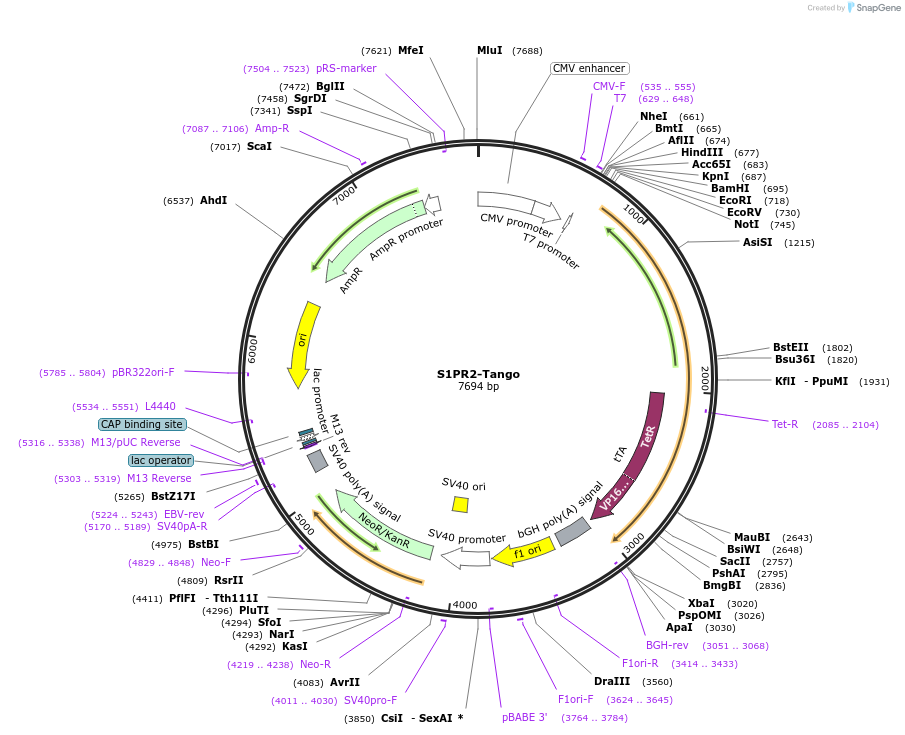-
PurposeExpression of G protein-coupled receptors for PRESTO-Tango: parallel receptorome expression and screening via transcriptional output, with transcriptional activation following arrestin translocation
-
Depositing Lab
-
Sequence Information
Ordering
| Item | Catalog # | Description | Quantity | Price (USD) | |
|---|---|---|---|---|---|
| Plasmid | 66497 | Standard format: Plasmid sent in bacteria as agar stab | 1 | $89 | |
Backbone
-
Vector backboneempty Tango
- Backbone size w/o insert (bp) 6632
-
Vector typeMammalian Expression
-
Selectable markersNeomycin (select with G418)
Growth in Bacteria
-
Bacterial Resistance(s)Ampicillin, 100 μg/mL
-
Growth Temperature37°C
-
Growth Strain(s)DH5alpha
-
Copy numberHigh Copy
Gene/Insert
-
Gene/Insert nameS1PR2
-
Alt nameEDG5
-
SpeciesH. sapiens (human)
-
Insert Size (bp)1059
-
Entrez GeneS1PR2 (a.k.a. AGR16, DFNB68, EDG-5, EDG5, Gpcr13, H218, LPB2, S1P2)
- Promoter CMV
-
Tag
/ Fusion Protein
- FLAG (N terminal on backbone)
Cloning Information
- Cloning method Restriction Enzyme
- 5′ cloning site NotI (not destroyed)
- 3′ cloning site XhoI (unknown if destroyed)
- 5′ sequencing primer CMV-F
- 3′ sequencing primer Tet-R
- (Common Sequencing Primers)
Resource Information
-
Articles Citing this Plasmid
Terms and Licenses
-
Academic/Nonprofit Terms
-
Industry Terms
- Not Available to Industry
Trademarks:
- Zeocin® is an InvivoGen trademark.
Depositor Comments
Please note: Most of the PRESTO-Tango vectors do not contain the XhoI cut site downstream of the tTA sequence and instead carry an XbaI site. If you need to perform an XhoI digest we recommend sequencing with a forward primer at the C-terminus of tTA to determine which of the two sites is present. Suggested primer: 5-gagctccacttagacggcgagg-3. Original backbone was pcDNA3.1(+). These plasmids were generated as part of the Illuminating the Druggable Genome (IDG) program sponsored by the NIH Common Fund. The goal of this program is to identify, gather, and distribute information and resources for proteins that currently are not well-studied yet belong to commonly drug-targeted protein families: protein kinases, non-olfactory G-protein coupled receptors (GPCRs), and ion channels. The IDG program is designed to develop fundamental research tools for understudied proteins, elucidate their function, and disseminate the IDG-related resources and data to the greater scientific community.
These plasmids were created by your colleagues. Please acknowledge the Principal Investigator, cite the article in which the plasmids were described, and include Addgene in the Materials and Methods of your future publications.
-
For your Materials & Methods section:
S1PR2-Tango was a gift from Bryan Roth (Addgene plasmid # 66497 ; http://n2t.net/addgene:66497 ; RRID:Addgene_66497) -
For your References section:
PRESTO-Tango as an open-source resource for interrogation of the druggable human GPCRome. Kroeze WK, Sassano MF, Huang XP, Lansu K, McCorvy JD, Giguere PM, Sciaky N, Roth BL. Nat Struct Mol Biol. 2015 May;22(5):362-9. doi: 10.1038/nsmb.3014. Epub 2015 Apr 20. 10.1038/nsmb.3014 PubMed 25895059



